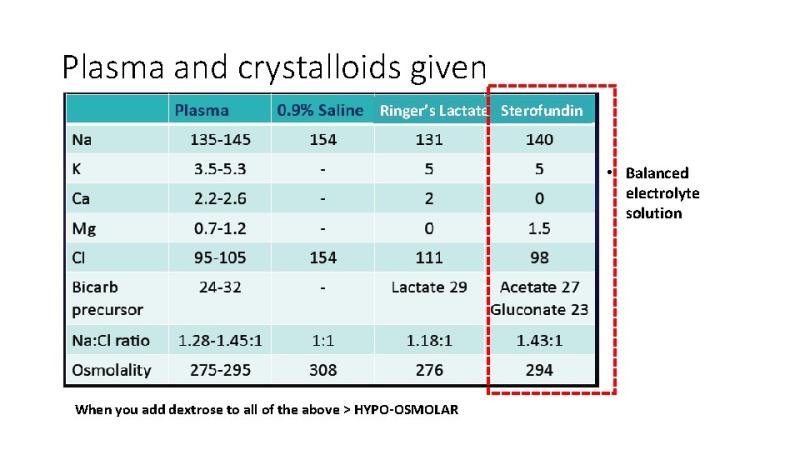When to use LR or PlasmaLyte after IV fluids?
The choice between using Lactated Ringer's (LR) and PlasmaLyte as intravenous (IV) fluids depends on several factors, including the patient's clinical condition, underlying medical conditions, and specific electrolyte needs. Healthcare providers typically consider the following guidelines when deciding which IV fluid to administer:
Patient's Clinical Condition:
- LR is often preferred for patients with normal or near-normal kidney function. It contains lactate as a buffer, which can be converted into bicarbonate in the body and helps to correct metabolic acidosis.
- PlasmaLyte, on the other hand, may be preferred in patients with impaired kidney function or a history of kidney disease because it has a lower potassium and lactate content compared to LR.
Electrolyte Composition:
- LR contains sodium, potassium, calcium, and lactate. It is isotonic and has a pH of approximately 6.5.
- PlasmaLyte contains sodium, potassium, calcium, and magnesium. It has a pH closer to physiological pH (around 7.4).
- Depending on a patient's electrolyte needs, one solution may be more appropriate than the other. For example, if a patient has a significant potassium deficit, a healthcare provider may choose PlasmaLyte, which has less potassium than LR.
Metabolic Acidosis:
- LR is often used in the treatment of mild to moderate metabolic acidosis due to its lactate content, which can be converted to bicarbonate in the body.
- PlasmaLyte may be considered in metabolic acidosis cases as well, but it has a pH closer to normal physiological pH.
Kidney Function:
- LR may not be the best choice for patients with kidney disease or impaired kidney function due to its potassium and lactate content, which can potentially lead to hyperkalemia and metabolic acidosis.
- PlasmaLyte, with its lower potassium and lactate content, may be preferred for patients with kidney issues.
Specific Patient Considerations:
- Each patient is unique, and their medical history, current condition, and individual electrolyte imbalances should be considered when selecting an IV fluid. Consult with a healthcare provider to determine the most appropriate choice for each patient.
It's essential to note that the choice between LR and PlasmaLyte may also depend on institutional policies, local practices, and the availability of these fluids. Healthcare providers should follow their hospital's protocols and guidelines for IV fluid selection. Additionally, patients with certain medical conditions or who are on specific medications may have unique fluid requirements, so individualized care is crucial.
Choosing Between LR and PlasmaLyte in IV Fluid Therapy
Intravenous (IV) fluid therapy is a common medical intervention used to replace lost fluids, electrolytes, and nutrients. Two commonly used crystalloid solutions for IV fluid therapy are Lactated Ringer's (LR) and Plasma-Lyte. Both LR and Plasma-Lyte are isotonic solutions, meaning they have the same osmolarity as plasma. However, they differ in their electrolyte composition.
LR contains sodium chloride, potassium chloride, lactate, and water. Lactate is metabolized by the liver to bicarbonate, which helps to correct metabolic acidosis.
Plasma-Lyte contains sodium chloride, potassium chloride, magnesium chloride, acetate, gluconate, and water. Acetate and gluconate are metabolized by the body to bicarbonate, similar to lactate.
Indications for LR and PlasmaLyte Based on Patient Needs
The choice of LR or Plasma-Lyte for IV fluid therapy depends on the patient's individual needs.
LR is generally a good choice for patients with metabolic acidosis, hyperlactatemia, or hyponatremia.
Plasma-Lyte is a good choice for patients with hyperchloremia, hypomagnesemia, or patients who are at risk of developing metabolic acidosis.
Electrolyte Composition and Osmolarity Differences Between the Two
Here is a table comparing the electrolyte composition and osmolarity of LR and Plasma-Lyte:
| Electrolyte | LR (mEq/L) | Plasma-Lyte (mEq/L) |
|---|---|---|
| Sodium | 140 | 140 |
| Chloride | 109 | 109 |
| Potassium | 4 | 5 |
| Lactate | 28 | 0 |
| Magnesium | 0 | 3 |
| Acetate | 0 | 16 |
| Gluconate | 0 | 23 |
| Osmolarity | 279 | 279 |
4. Clinical Considerations for the Use of LR and Plasma-Lyte
In addition to the electrolyte composition and osmolarity of the two solutions, there are other clinical considerations that should be taken into account when choosing between LR and Plasma-Lyte. These include:
The patient's renal function: Patients with reduced kidney function may be more susceptible to electrolyte disturbances from LR or Plasma-Lyte.
The patient's cardiac function: Patients with heart failure or other cardiac conditions may be more susceptible to fluid overload from LR or Plasma-Lyte.
The patient's acid-base status: Patients with metabolic acidosis may benefit from LR, while patients with hyperchloremia may benefit from Plasma-Lyte.
Best Practices for IV Fluid Selection in Various Scenarios
Here are some best practices for IV fluid selection in various scenarios:
Hypovolemic shock: LR or Plasma-Lyte can be used to treat hypovolemic shock. However, LR may be preferred in patients with metabolic acidosis, while Plasma-Lyte may be preferred in patients with hyperchloremia.
Maintenance fluid therapy: LR or Plasma-Lyte can be used for maintenance fluid therapy in patients who are unable to take fluids by mouth.
Surgery: LR or Plasma-Lyte can be used to replace fluids lost during surgery.
Burn injury: LR or Plasma-Lyte can be used to treat burn injury.
It is important to note that these are just general guidelines. The best choice of IV fluid for a particular patient should be made by a healthcare professional who is familiar with the patient's individual needs.












